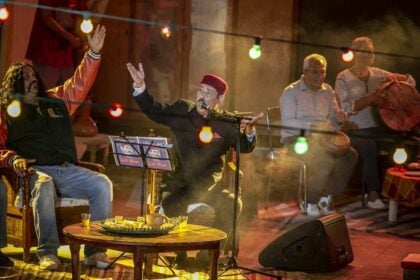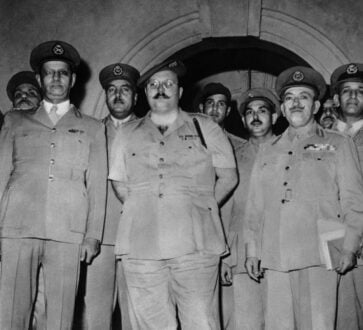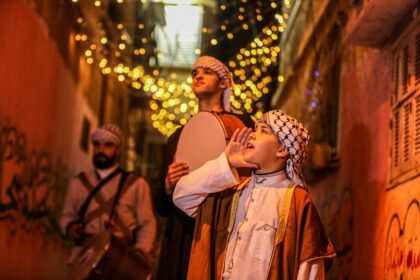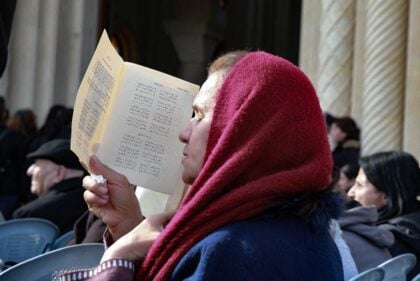
Introduction
The culture of Jordan is generally full of aesthetics and creative aspects. The first works of the cultural life in Jordan emerged at the turn of the 20 th century. With the foundation of Transjordan in 1921, Emir Abd Allah Al-Awal ibn Al-Husayn included literary salons in the royal court that effectively contributed to the emergence of literal, cultural and intellectual movements. These salons turned out to be an attractive climate for litterateurs and other educated people, and played a significant role in motivating a lot of creative talents to surface. And thus, the educated Jordanian character emerged, shined, and soared in the Arab national sphere.
Jordanian culture combines between elements of the past and the present, and between Islamic heritage and modern culture. It also embraces eastern culture and accepts western cultures, not to mention being an extension to the surrounding Arabian culture, even its cuisine, even though it has its distinctive characteristics.
Studies that recorded the literary movements in Jordan and studied story art through its prominent figures, indicate that Khalil Beidas was a pioneer of the short story in Jordan, Palestine and the Arab world too since the beginning of the 20th century.
Jordan’s terrain and distinctive geography, its unique history and the contributions of Palestinians affected the Jordanian culture generally. This uniqueness encouraged the country reviving the Jordanian identity – especially between the 60s and 70s of the 20th century – in folklore dance, music, fashion and other aspects of Jordan’s cultural life. All ethnic and religious groups still have their own heritage in Jordan, such as Circassians, Turkmen, Chechens and Christians. Jordanians learned to accept each other and became more open. It is possible to say that the Jordanian theatre did not start establishing itself as an artistic movement that has the elements of continuity, growth, spread and development until the beginning of the last century’s 60s.
Jordanians practiced different kinds of handicrafts ; most notably textiles as the world’s most ancient handicraft. Some of the most ancient Islamic pottery pieces were found in Jordan, dating back to the 2nd and 3rd centuries AH (between the 8th and 10th centuries). Ceramics and pottery crafts are still practiced in Jordan until today, along with many other traditional crafts such as Wood engraving, glass making and colored sand.
The Jordanian monuments and archeological sites are considered among the most prominent landmarks in the world, as Jordan witnessed several kingdoms across different historical stages, such as the Ammonites kingdom and its capital (Rabbah Ammon), the Moabities kingdom In Madaba and Karak, Edomites kingdom centered in Tafilah, and the Nabataean Kingdom whose most important monument is Petra.
To learn more about the culture of Jordan, please see what fanack has covered about this file.
Literature
Jordanian literature – both prose and poetry – is the pre-eminent form of artistic expression. Jordanians have long enjoyed poetic contests between two teams, the winning team being the one that could recite the most poetry; such contests are still held today. A young Bedouin used to be taught poetry – in addition to fighting and horse riding – even before he learned to read and write.
Jordanians appreciated the Arab language, and a person who spoke eloquently was highly esteemed. Poetry was an important form of expression. One of the pre-eminent Jordanian poets of the 20th century was Arar (Mustafa Wahbi al-Tall), famous for the social content of his poetry, which deals mainly with the poor, the underprivileged, and the life of Jordan’s gypsies.
The Jordan Writers Association was formed to help Jordanian poets and writers to stimulate literary life in the kingdom.
There are many short-story and novel writers in Jordan, and many Bedouin television series have been based on their works. Short stories written by local writers between 1970 and 1998 focused on social issues and problems, as well as on the Palestinian cause. Jordanian poetry has matured over recent decades and is beginning to focus on national issues, such as women, poverty, education, workers, and pan-Arab affairs.
Music and Dance
Jordanian music is not as popular as that of other Arab countries, such as Egypt and Lebanon. Perhaps the most popular form of music in Jordan is patriotic songs that celebrate country and king and are strongly influenced by Bedouin culture.

There is also a type of Bedouin music that relies mostly on one instrument, the rebab or al-rababa (a stringed instrument) and sometimes the mijwiz (reed pipe). Songs of this type usually tackle issues such as raids, battles, and generosity, and they often have a melancholy sound.
Jordan’s famous traditional dance is the dabke or dabka, a group dance that involves stamping one’s feet. This dance is performed by men and women, and it employs a variety of steps that differ from region to region. Another form of dance famous among the Bedouin is the sahja or sahaja, which involves groups of men as large as twenty.
Most gyms have recently started offering belly-dance lessons, which are popular among Jordanian women, and dance schools offer Latino dance lessons – e.g., in salsa – as well as ballroom dance. Many DJs and rappers have appeared in Jordan in recent years.
Crafts
Jordan is known for its handicrafts, including rug making, carpet weaving, baskets, pottery, ceramics, and embroidery. The country’s traditional handicrafts have been passed from generation to generation. Islamic and cultural diversions have affected Jordanian crafts, especially the decoration of pottery and ceramics. Crafts produced on a smaller scale include decorated sand bottles, sculptures, and handcrafted silver jewellery.
The non-profit, non-governmental Jordan River Foundation, which was established in 1995 and is now headed by Queen Rania, has been improving the quality of life for many Jordanian women and their families in rural areas, by encouraging handicraft production and undertaking other projects to empower youth and women.
Traditional Arts
Jordan’s traditional ceramics and famous mosaics incorporate Islamic motifs and are all handmade. The calligraphy on some ceramics depicts the art of the Umayyad and Mamluk periods. In 1992, the government started a mosaics school in the city of Madaba, which is home to the oldest mosaic map, which depicts the Holy Land and dates to the 6th century CE. The school aims to preserve and restore old mosaics on archaeological sites.
Embroidery is another famous traditional Jordanian art. Women of Palestinian origin make traditional embroidered dresses, using varied colours and patterns, based mostly on geometric designs.
Contemporary Arts
There are many art galleries in Amman, especially in older parts of the city, such as al-Weibdeh and Jabal Amman. These galleries host contemporary artists from Jordan and other Arab countries – mostly Iraq – and showcase various contemporary arts, including painting, sculpture, and ceramics. Many Iraqi artists fled to Jordan after the American-led war and settled in the kingdom, where they now present their work. Some have started their own galleries.
Popular Culture
Jordan’s popular culture is much influenced by Egyptian, Lebanese, Syrian, and, most recently, Turkish music and television series, which young Jordanians have been watching and listening to in the 21st century. Jordanians grew up watching Egyptian and Syrian soap operas and, because they are broadcast on satellite channels, Turkish soap operas have become very popular over the past years.
Abu Mahjoob, a caricature character created by cartoonist Emad Hajjaj, has become very popular for depicting Jordanian’s lives in a satirical manner. Abu Mahjoob represents the average Jordanian citizen, with his or her daily struggles and aspirations.
Theatre and Film
Jordan’s movie theatres show foreign-language films, primarily in English. Most movie theatres play modern American commercial movies, except on culture nights dedicated to international movies, which are usually sponsored by international entities such as the European Union. Theatres also host national and international dance groups, singers, and actors.
Jordan’s Royal Film Commission was established in 2008 to develop the competitiveness of the Jordanian movie industry regionally and internationally.
Museums
There are thirteen museums in Amman, ranging from heritage museums to children’s museums. These include the Children’s Museum, the Jordan Archaeological Museum, the Jordan Folklore Museum, the Jordan Museum of Popular Tradition, the University of Jordan Museums, the Jordan National Gallery of Fine Arts, the Haya Cultural Centre (for children), the Municipality of Greater Amman, the Darat al-Funun, the Royal Automobile Museum, the Martyr’s Memorial, and the Numismatics Museum of the Central Bank of Jordan.
Outside Amman are the Madaba Archaeological Museum, the Salt Archaeological Museum, the Salt Folklore Museum, the Jerash Archaeological Museum, the Aqaba Archaeological Museum, the Petra Nabataean Museum, the Petra Archaeological Museum, the Irbid Archaeological Museum, the Museum of Jordanian Heritage, the Dar al-Saraya Museum, the Umm Qais Archaeological Museum, the Karak Archaeological Museum, the Mazar Islamic Museum, the Ajloun Archaeological Museum, and the Dead Sea Panoramic Complex.
Sports
Sports play an increasingly important role in the lives of Jordanians, most of whom are football fans. There are twelve professional football teams, the most popular of which are al-Faisaly and al-Wehdat. There are also ten women’s professional football teams, men’s and women’s national football teams, an Olympic football team, and a youth football team.

The Jordanian national team started its international venue in the qualifications of Mexico’s 1986 World Cup. Since then, the team has maintained its presence in this venue. His best participation in the 2014 World Cup qualifications the best ever. At that time, the national team succeeded in advancing towards the last step of the qualifiers against Uruguay in the FC-CONMEBOL play-off. On the continental level, the Jordanian national team qualified to the Asian Cup on four occasions in 2004, 2011, 2015 and 2019. The national team participated once in the Youth World Cup. That was in the U-20 World Cup Championship in Canada 2007. In October 2020, Jordanian’s national football team ranked 97 in FIFA’s world ranking table.
There are 34 sports unions in the country, all under the Jordan Olympic Committee. Jordanian youth also enjoy basketball. Most private schools have basketball teams that take part in local championships. Jordan’s national basketball team represents the country at international championships; it qualified for the World Cup in Turkey in 2010.
Some Jordanian players have excelled in table tennis and have represented the kingdom in international championships, returning home with medals. Fast walking has taken Amman by storm since it was organized in 2006 to encourage a healthy life through walking. Twice a week, hundreds – sometimes more than a thousand – Jordanians and foreigners walk the streets of Amman wearing green vests. Organizers, wearing orange vests and carrying red lights and stop-signs, stop traffic while the walkers cross the streets.
Latest Articles
Below are the latest articles by acclaimed journalists and academics concerning the topic ‘Culture’ and ‘Jordan’. These articles are posted in this country file or elsewhere on our website:













